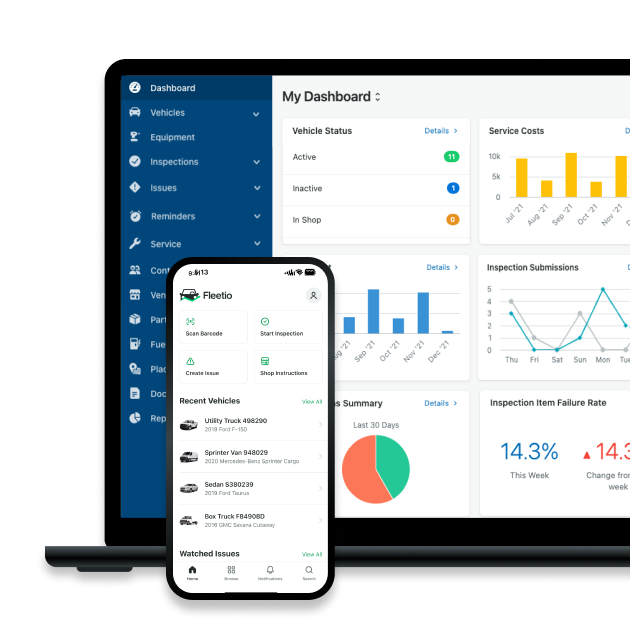Managing a Fleet of Hundreds: Automate Your Fleet Operations
Big companies need big fleets, but because fleets tend to be a cost center as much as they are a resource, it can be hard to truly optimize a large fleet without taking some equally large steps toward efficiency. Here are a few tips for enterprise fleets looking to streamline their operations.
Sep 26, 2023
5 min read

Automate as much as possible
Large fleets have the capacity to intake a lot of data, and it can be really easy to get lost in that sea of metrics. If you want to get real value out of your data instead of just letting it float around in the cloud, automation is the most straightforward means of taking a large, multi-faceted process and reducing it down to a more easily understood and organized operation.
As fleet technology has expanded, the amount of ways to automate your fleet management system have grown exponentially, and there are products and solutions designed to streamline nearly everything in a fleet. Many large fleets employ some level of automation in their management strategy, but there are plenty of easily automated processes that you may be missing out on:
-
Route Planning and Optimization: Automated route planning software considers various factors like traffic, weather, vehicle capabilities and delivery schedules to optimize routes, which in turn reduces fuel consumption, minimizes travel time and lowers operational costs.
-
Telematics and Fleet Tracking: GPS-based tracking and telematics systems provide real-time data on vehicle location, speed and performance, and that data can then be used for dispatching, monitoring driver behavior and preventive maintenance scheduling.
-
Maintenance Scheduling: Predictive maintenance systems can use sensor data to identify when vehicles or equipment are likely to require maintenance or repairs, which means fewer breakdowns and reduced downtime.
-
Inventory Management: For fleets that involve shipping or logistics, automated inventory management systems can track cargo, provide real-time updates to clients, and help manage warehouse operations more efficiently.
-
Fuel Management: Automation can help monitor and control fuel usage through technologies like fuel sensors, fuel cards and data analytics. This can lead to cost savings and a reduced environmental footprint.
-
Compliance and Regulatory Reporting: Automation can assist in monitoring compliance with various regulations, such as hours-of-service (HOS) rules for drivers or emissions standards. It can also generate required reports more efficiently.
-
Fleet Analytics: Data analytics tools process vast amounts of data generated by fleet operations to provide insights into driver behavior, vehicle performance and operational efficiency.
-
Driver Training and Monitoring: Automated training programs and driver monitoring systems do a lot to improve driver behavior, reduce accidents and enhance overall safety without being invasive.
-
Customer Communication: Automated communication systems can keep customers in the loop on the status of their deliveries or services, which improves customer satisfaction and eliminates the need for manual updates.
-
Load Optimization: Automated load planning and optimization tools help to ensure that vehicles are loaded efficiently, reducing wasted space and fuel consumption.
-
Paperless Documentation: Transitioning to digital documentation and electronic signature systems reduces paperwork, improves record-keeping accuracy and streamline administrative tasks.
-
Remote Diagnostics: Remote diagnostics systems can identify vehicle issues in real-time and provide insights to maintenance teams, allowing them to proactively address problems.
-
Supply Chain Visibility: Integration with suppliers and partners through automated systems can provide end-to-end visibility into the supply chain, helping to predict and mitigate disruptions.
-
Safety and Security: Automation can improve safety through features like automated emergency braking, collision avoidance systems and theft detection.
-
Driver Assistance Systems: Advanced driver assistance systems (ADAS) can automate certain aspects of driving, such as adaptive cruise control, lane-keeping assistance, and automatic braking, improving safety and reducing driver fatigue.
Need a better way to keep track of your assets?
Make informed fleet decisions using real-time data and streamline your enterprise fleet’s processes with our customizable, scalable platform.
Tell me moreMake smart software choices
If automation is the route to efficiency, then choosing the correct software that gets you where you need to be is of utmost importance. Here are the two biggest things you should consider when looking at fleet management software features:
1. Ease of Implementation and Use
The biggest barrier to integrating new solutions into your fleet is getting maximum buy-in from everyone in your operation. Consult with everyone who will interface with the product, including drivers, technicians, IT, finance and other important departments to ensure that everyone will be able to easily use the solution you choose.
You’ll also want to make sure that the company has a system in place to onboard enterprise fleets, so they can help you transfer data and train users for optimal adoption.
2. Scalability and Integrations
Scalable fleet software solutions allow you to thrive at your current size while also accommodating future growth, which is every company’s end goal. Explore solutions that cater to your fleet’s specific needs and allow pricing based on your size and feature usage while opening the door for expansion down the road.
Also keep an eye out for providers that are constantly expanding their integrations library – being able to keep all of your data aligned in your software solutions will save you time and effort in reporting and let you get the most out of all the data you’re collecting from your fleet.
Stay proactive
Large fleets tend to have pretty complex maintenance operations, whether they handle their repairs and service 100% internally or by partnering with a third-party service provider. But the single most important facet of an efficient fleet, no matter what size it may be, is choosing to pursue a proactive approach in maintenance.
Being proactive goes beyond just having a solid PM schedule – you’ll want to bake proactivity into every touchpoint with your vehicles. Here’s three places to look for opportunities to be more proactive.
1. Stay on top of your DVIRs
DVIRs are your first line of defense for any vehicle issue, but if you’re only using them as a compliance safety net, you might be missing a source of knowledge on the state of your vehicles before something goes wrong. Make sure drivers are consistently submitting thorough documentation of their pre- and post-trip inspections, and don’t just store them – use them for day-to-day insights.
2. Continually reevaluate your maintenance key performance indicators:
It really is good to have goals – solid KPIs that you reset regularly can help keep you on pace and moving toward more efficient operations. Useful maintenance KPIs include repair turnover rate, technician efficiency , work order completion and other maintenance specific measurements so you can begin to steadily decrease downtime.
3. Get a solid fleet maintenance platform
A fleet management software designed for large fleets can help you take bigger steps toward automating your maintenance process, as well as help you monitoring your fleet and technician performance, standardizing your DVIRs in a digital format, sending automatic notifications for PM services and storing all of your maintenance data in one central location.
Manage everything in Fleetio
Want an integrated platform that can help you manage all of your assets more efficiently?
Schedule your guided tour
Senior Fleet Content Specialist
As a Senior Fleet Content Specialist at Fleetio, Peyton explores the voices and experiences that shape fleet operations. She focuses on how fleet professionals adopt technology, improve efficiency and lead their teams to bring clarity and context to the challenges happening across the industry.
View articles by Peyton PanikReady to get started?
Join thousands of satisfied customers using Fleetio
Questions? Call us at 1-800-975-5304
